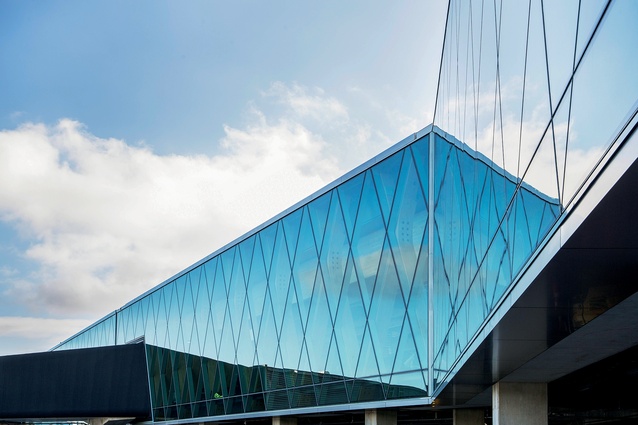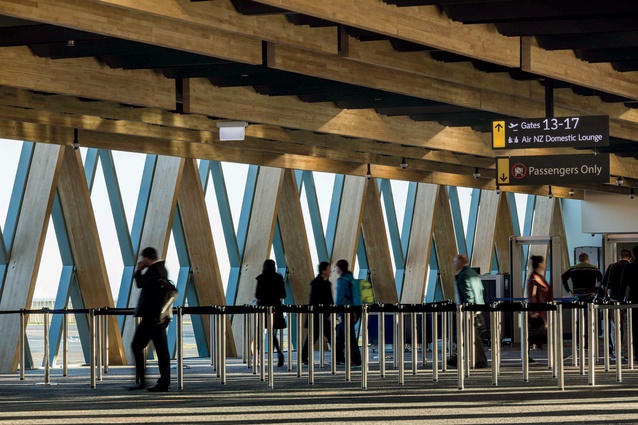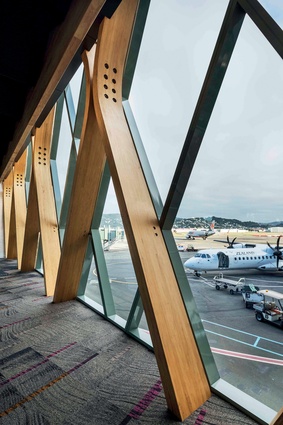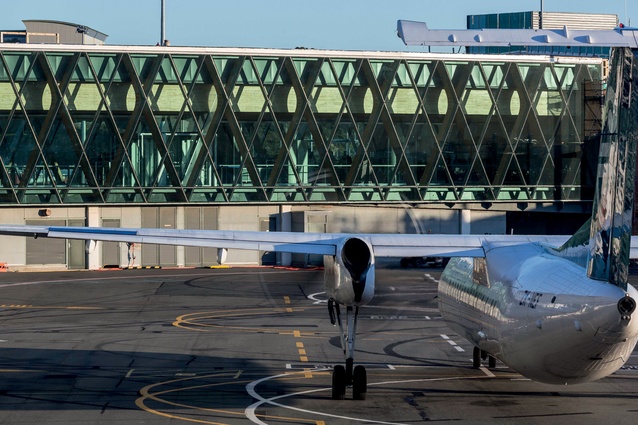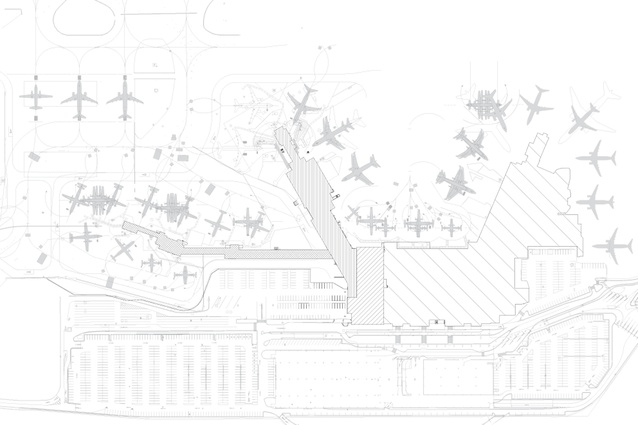Wellington International Airport Terminal: South Extension
Wellington Airport's latest addition, by Warren and Mahoney, is the main entry point for Wellington's frequent domestic travellers, featuring a ‘net’ of angled cross-frames that stretch between existing buildings.
Wellington’s airport has always been a bit edgy. It is on the wild South Coast, clinging onto the edge of the coolest little capital in the world. The runway extends, cautiously, out into the jagged rocks and (sometimes) wild raging waters of Cook Strait. The Wahine was wrecked not far from here. Orca, dolphins and even humpback whales periodically cruise past, just offshore. Tsunami have washed over the land nearby. Orcs and huge angry weta have roamed the earth just over the hill behind, while giant eagles still soar in the terminal itself. This is, after all, the Home of Middle Earth: the airport is, literally, Wild at Heart.
Flying into Wellington is like a public spectator sport, with flight paths descending over the city and right past the windows of folks living in Roseneath. If your flight is descending into a strong southerly, you can almost see what they are cooking for dinner. It’s not quite as scary as Hong Kong’s Kai Tak Airport was, but, at times, it is just as entertaining.

Sure, the site is a bit cramped and the runway could do with being a bit longer, but the convenience of having an airport only one bay away from the CBD is undeniable: just 15 minutes’ taxi ride to Parliament, which means a lot to MPs and businesspeople alike.
While many countries sport huge new airport terminals, bristling with slick, super-modern, lightly floating roofs by famous titled architects on impossible budgets, New Zealand airports aren’t like that. Wellington’s original airport terminal was, for many years, a shameful state of affairs: an old cargo shed, sparsely converted, wind whistling through the gaps.
In the 1990s, the unloved metal box was demolished and architects Craig Craig Moller (CCM) replaced it with a sleek new design: a beautifully detailed aerofoil roof sitting on long V-shaped trusses spanning from the entry check-in desks across to the vast angled glass wall, looking out to the planes and to the cresting surf-break beyond.

The CCM-designed terminal hall still works well but steadily increasing passenger numbers meant that more space was needed, with a projected 10 million passengers expected annually by 2020. Catering for growth in the international market, The Rock (Wellington International Airport Terminal, by Studio Pacific in association with Warren and Mahoney (WaM)) hunkers down like a limpet; a crusty, copper-clad protuberance on the northern lip of the airport. The latest addition expands to the south, providing the main entry point for the Wellington jet set: the frequent domestic travellers.
WaM has extended three and a half new structural bays in the Main Terminal, while the thin Southern Pier (for provincial services in propeller-driven aircraft) has been doubled in width and provincial users now have their own Regional Koru Lounge and comfortable waiting room in the Main Terminal.

Most importantly, the South West Pier has considerably been fattened up and transformed, with a striking new appearance. If The Rock is a limpet, then the new pier is a hīnaki – an eel net, with woven walls holding onto the fresh catch of wriggling travellers. The timber columns are tall and steeply inclined, leaning over to their neighbour, almost touching but not quite. Instead, they lightly ‘kiss’ each other near the apex; eight neatly-cut bolt holes are the only giveaway to the location for a seismic fuse, tying the columns together securely.

While the glazing continues in a regular diamond fish-net pattern outside, the space in between the columns creates an eddy, capturing people from the main flow. A place for the small fish to gather, take in the stunning views, and wait to swim onboard.
This is the sort of project where everyone deserves to take a bow, as the roles were all heavily interwoven. Katherine Skipper, Ralph Roberts and Rodney Sampson, from WaM, worked closely with Alan Henderson from Beca in a tightly-controlled build by Hawkins Construction where the airport had to remain fully operational at all times. Full credit also to Techlam in Levin, which lovingly crafted these giant sticks of pine. Timber redefined indeed!
The 450x150mm timber members are laminated together in thin layers, supported below floor level on a grunty steel angle and each is pinned to the lintel at the top with a single big stainless-steel bolt. The 7m-high Thermosash glazing panels are connected to the timber at only three points and sit lightly, hanging just clear of the timber, connected with simple, beautifully-made brackets. The whole overall effect is stunning: beauty is in the details.
While the bold weaving of the walls is the strongest design feature, both the ceiling and the floor also have strong design elements. More massive timber-laminated beams in the ceiling, apparently free-hanging, actually support the extensive servicing hidden in the ceiling, and their monumental scale and directionality point you firmly towards the planes.
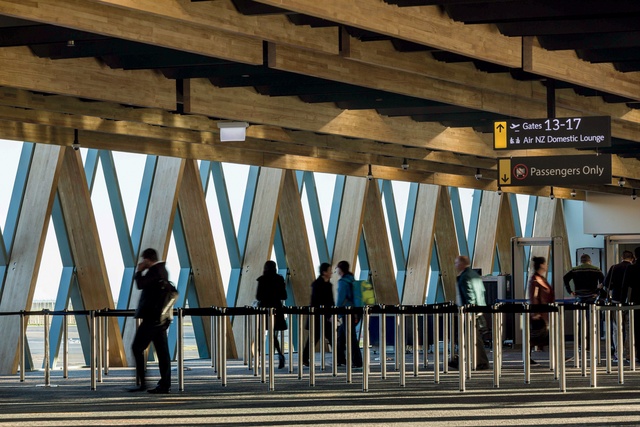
There’s a whole lot of carbon capture going on right here, subtly reminding the MPs of the importance of combating climate change. The light pine colour is offset against jet-black ceiling panels, crinkling in a concertina fashion across the ceiling.
Floor treatment is always vital in an airport. The previous iteration of the main terminal’s interior had a carpet with the appearance of rocks, allowing a sliver of satisfaction that every time a politician was being interviewed at Wellington airport, you knew – and could see on the TV news – that the politician was literally standing on rocky ground.
In the new extension, the rocks have been replaced by a new colour weave of greys, with red and yellow splashes of colour, like the rippling light that falls on Wellington Harbour and reflects off its surface. The pattern becomes more complex, and lighter or darker, depending on usage and, in a lovely touch, features woven works by local artists of nearby locations like Red Rocks. You are sitting amidst their art as you wait for a plane, relaxing by the sea. Your flight is called: it’s time to go.

